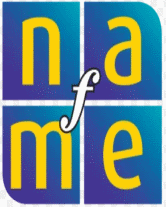The activities in this section are effective in helping children:
- alone, and with a group, become increasingly accurate in rhythm andpitch
- carry out sequences of tasks
- develop large and small motor coordination
- experiment with a variety of instruments and other sound sources
- identify same/different
- improvise instrumental accompaniments to songs, recorded selections,stories, and poems
- invent and use original graphic or symbolic systems to representvocal and instrumental sounds and musical ideas
- make decisions about ordering of elements
- move in coordination with a group
- play simple melodies and accompaniments on instruments
- sing a variety of simple songs in various keys, meters, and genres
- solve puzzles
"On the Bridge at Avignon"
| This familiar French folk tune provides opportunities for invitingchildren to move to different ways "on the bridge." Children learn to attendto directions in the music (such as starting and stopping) as they makedecisions about different movements. Some teachers substitute the nameof their town or city for Avignon. |
Procedures
- Move in response to the music. (This can be done by you and by the children.)
- Invite children to substitute various developmentally appropriate motionsfor the entire group (such as walking, hopping, swaying, rocking, or clapping).
- Vary the tempo with this melody.
"Eency Weency Spider"
| Children of all ages love this song. There are many musical lessonsin this familiar activity, as children experience organization in phrases,physically respond to beat, and explore high and low. |
Procedures
- Sing the song with the children, leading them in the familiar motions associatedwith the lyrics.
- Create a puzzle strip of the song so that children can experience the phrasesboth aurally and physically.
- Provide children opportunities to explore the spider crawling up and downthe water spout on a pitched percussion instrument.
- Lead the children in singing the song in Spanish: La arana chica tejiosu telarana / vino la lluvia y se la llevo. / Salio el sol y seco la lluvia/ Y la arana chica otra vez tejio.
"Grandma Moses"
| This song involves vocal exploration through singing and speaking;sequencing two contrasting parts to the song, moving in response to thesong text, and playing instruments as an extension of body movements. Childrencan also improvise, substituting their own or their friends’ names for"Grandma Moses." |
Procedures
- Begin by leading the children in the actions that go with the secondpart of the song: "hands up, shakety shake, shake."
- Invite children’sideas about an instrument that we could shake; then add maracas or othersimple shakers. (Follow motion up, down, around, and on the ground.)
- Introduce the first part of the song, the song/speech section, to the children.
- Explain, "Put your hands on your waist while we begin the first part ofour song." This ensures that the children will use the instruments onlyin the "shakety shake" section; the motions will follow naturally.
- Sing the entire song with the motions and instruments.
- Ask the questions, "What did the doctor say to Grandma Moses?" "How didwe use our voices?" [Singing and speaking] "What did we do first, second…?"

"Are You Sleeping"
| This experience involves finding new ways to use this French folk tune.In addition to singing a familiar song, the children have a chance to identifysame/different parts of a song, make musical decisions about the order,or song sequence; improvise on a familiar melody, and construct a new melody. |
We also have the lyrics to "Frere Jaques" in six languages.
Procedures
- Sing the song many times with the children so that they know it well.
- Duplicate the pictures below for the children, cut them out and place in a ziplock bag. Sing and demonstrate how the "pictures" follow the melody. (Thechildren can also draw their own pictures for the phrases in the song.)
- Ask:
- How many parts are there in the song? [Children may say eight to represent the number of pictures; or they may say four with repeated parts.]
- Will you point to each part of the song as you sing?
- Will you turn over the parts/motives that are the same so that we cannot see the picture? Then,
- Will you sing that part in your head?


| Provided in partnership with NAfME |


